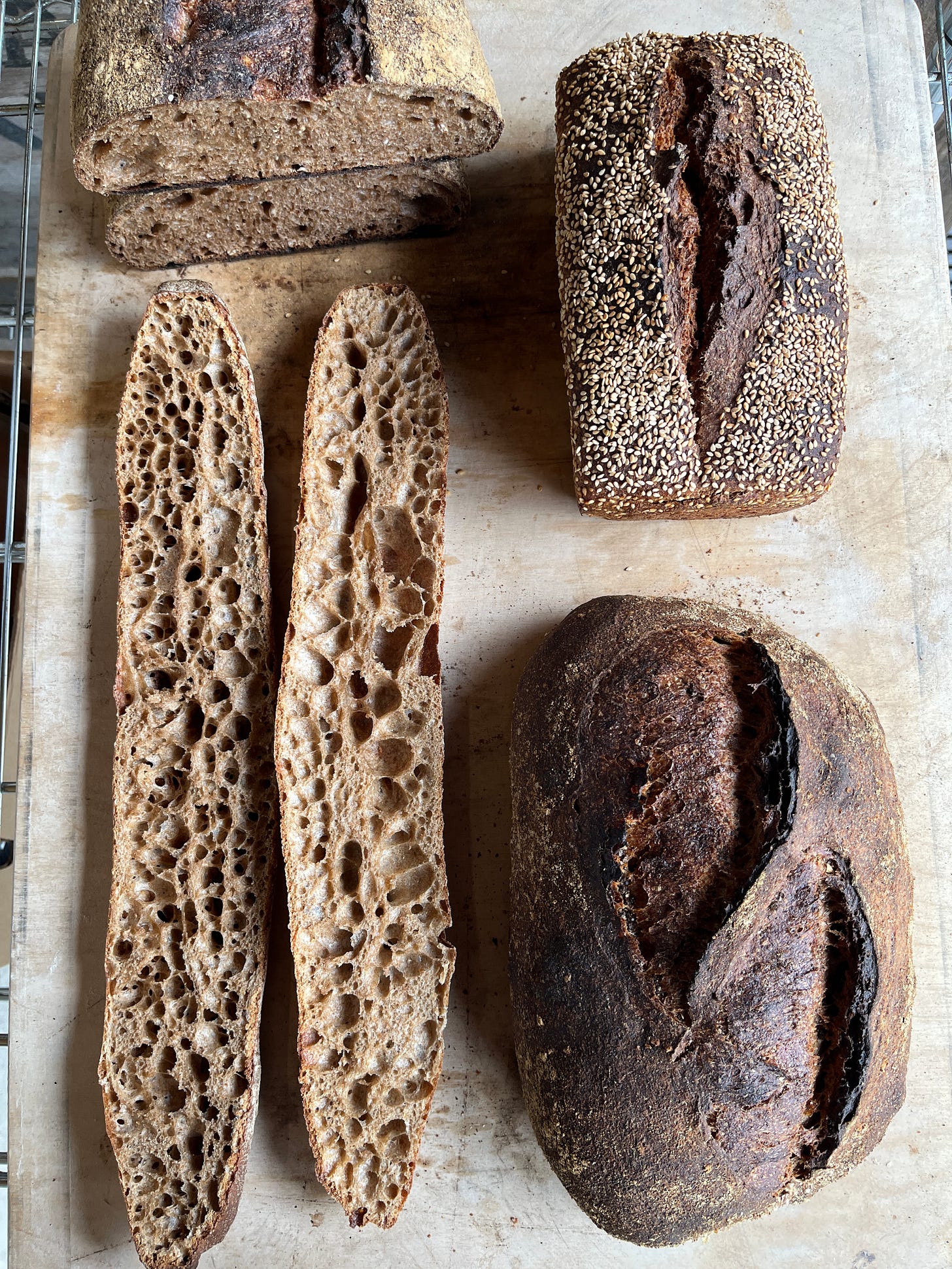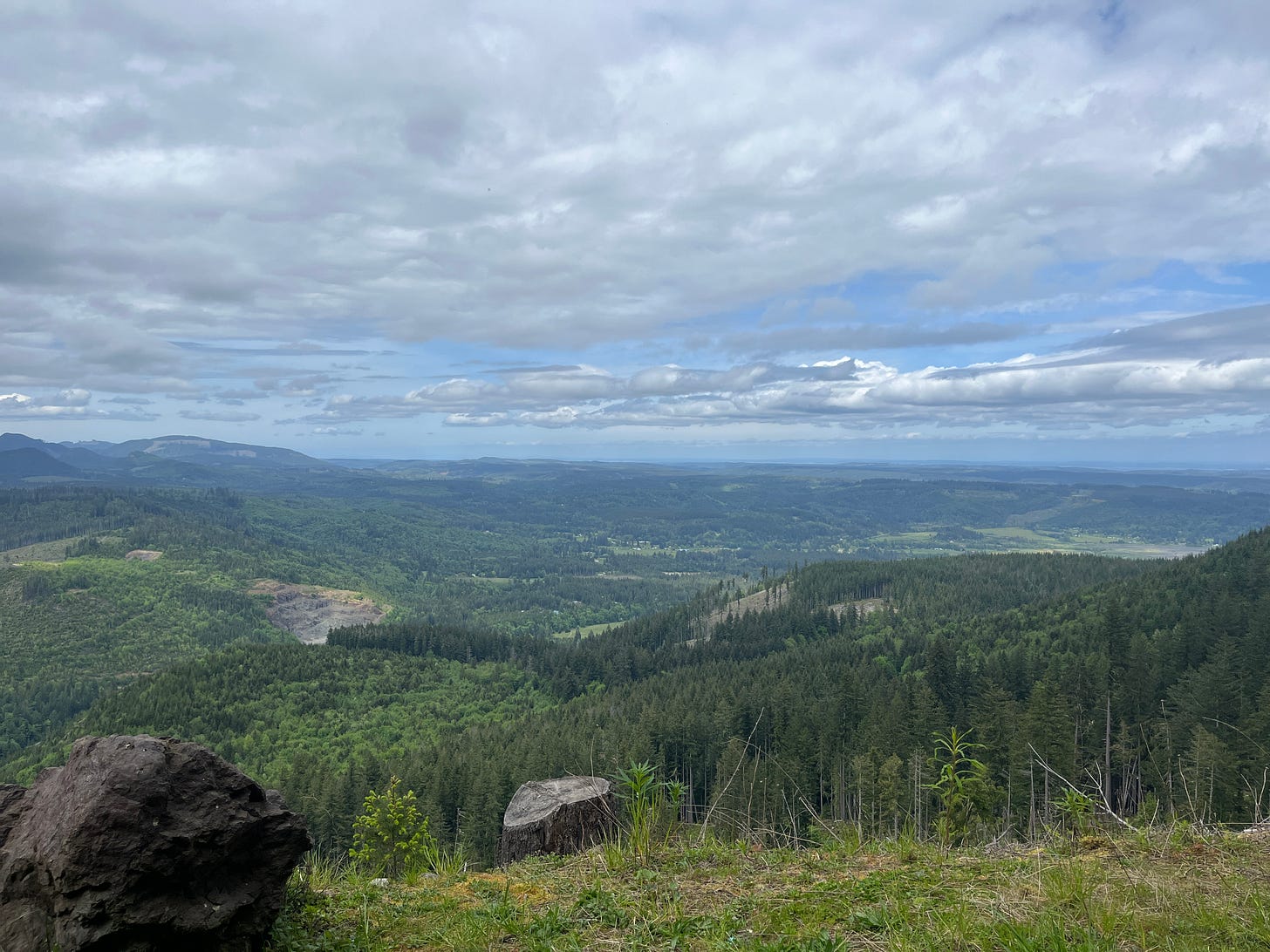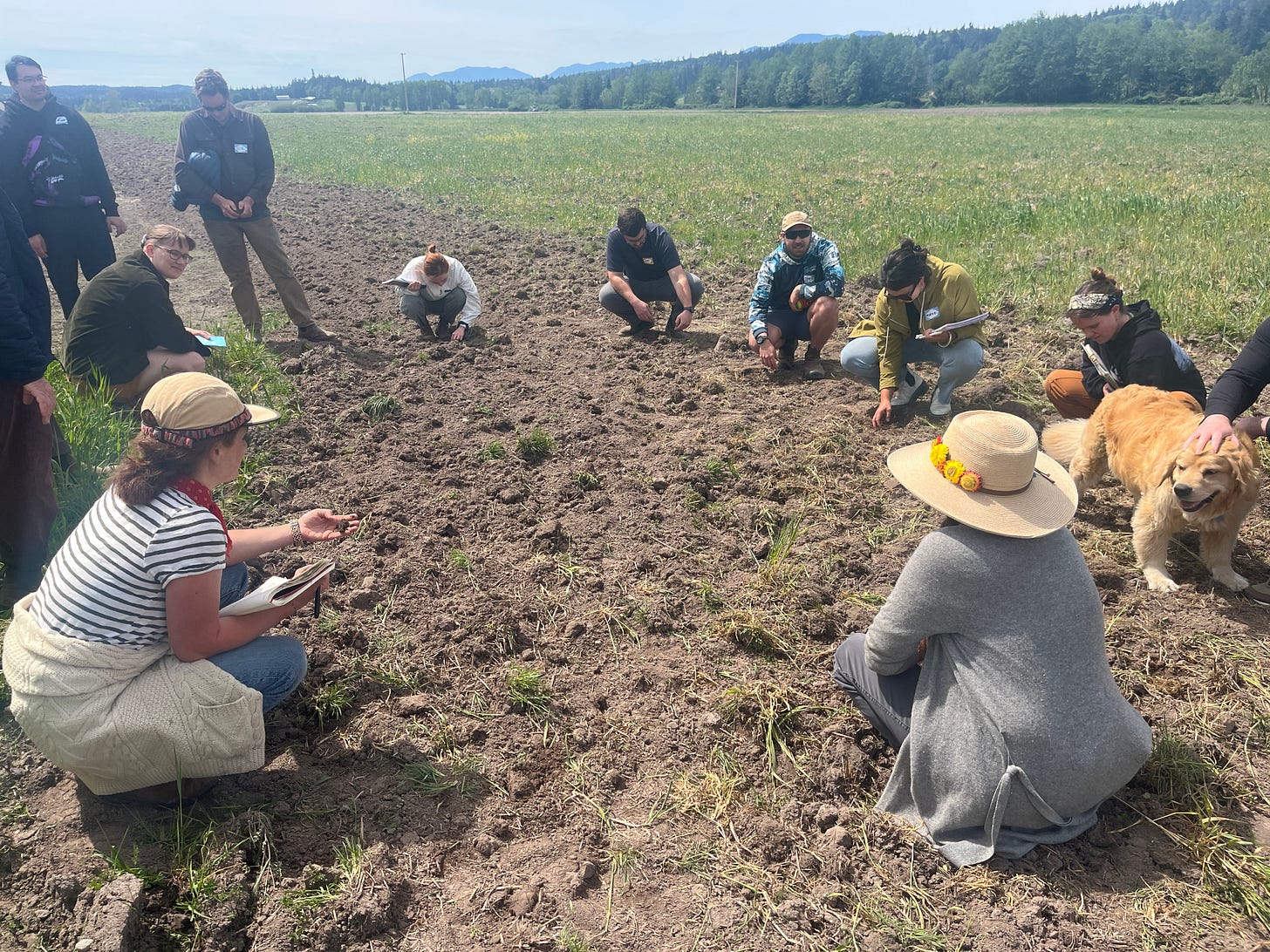Confluence
A Holy Trinity: Farming, Baking, and Milling in the Pacific Northwest
“All that we are is story. From the moment we are born to the time we continue on our spirit journey, we are involved in the creation of the story of our time here. It is what we arrive with. It is all we leave behind. We are not the things we accumulate. We are not the things we deem important. We are story. All of us.
What comes to matter then is the creation of the best possible story we can while we’re here; you, me, us, together. When we can do that and we take the time to share those stories with each other, we get bigger inside, we see each other, we recognize our kinship – we change the world, one story at a time…”
― Richard Wagamese
It starts like this:
I tell my students that bread is a story we tell about ourselves. I tell them that the shapes we form, the dough we knead, and the darkness to which we bake our loaves are the ingredients of these stories.
These ingredients create the flavor and the flavor creates the memory and the memory becomes the story we tell about our bread.
Then we say to the world, Here. This is my bread. Would you like to try some?
But what do the things we use to make our bread say about who we are? What stories do our ingredients tell about us?
This May I spent two weeks on the Olympic Peninsula in Chimacum, Washington. I was there to teach a professional class with their head baker Baylin and a class for home bakers with my friend Maurizio. In between these workshops, sleeping above the barn in a yoga studio, I learned about the most fascinating wheat project in the country.
Chimacum Valley Grainery doesn’t just tell the story of its place–a rural, but ag-gentrified corner of the Evergreen state. It doesn't just tell the story of its soil, its two granite stone mills, or its wood-fired ovens. What Chimacum Grainery does tell, unlike anywhere else I’ve been, is the story of all three components which make a loaf of bread: the farm, the mill, and the bakery. Because they perform all three of these rituals–farming, milling, kneading–I’ve never heard a story about bread told in such a voice.
It all began when a story changed their lives.
Imagine the late-90s: Cal Ripken was approaching his 2,000th game, a gallon of gas was $1.06, Che Pope was putting the finishing touches on The Miseducation Of Lauryn Hill, and two teenagers in Columbine, Colorado were about to change the world.
This is when Keith and Crystie Kisler read Wendell Berry’s The Unsettling of America, a book in which the author warns that America’s current farming practices will not just deplete its soil, but its entire society. After finishing it, Keith and Crystie decided to do something. They were young, broke, and committed to changing the world. But they didn’t want to outsource the change they wanted to see–they wanted to do it themselves.
In order to make a difference, to not participate in a story of agriculture which hurt America, they decided to buy a farm in Chimacum. (And by doing so, they participated in that other great American story–debt). With paper from the bank they bought 33 acres on Chimacum Valley’s floor and began to grow their own story of American agriculture.
“Finding beauty in a broken world is creating beauty in the world we find.”
― Terry Tempest Williams
They planted fields with grain that no normal combine, baker, or flour mill would touch: organic, heirloom, nutritious, diverse. They planted crops like spelt and clover and rye and buckwheat. Keith used the soil and the hills and the rainfall less like a farmer and more like a musician: he used trees and sandy loam and earthworms as instruments, not impediments to his unique seeds and diverse farming techniques. Crystie got involved with the Community and County, planting her own version of organic, heirloom, nutritious, and diverse seeds.
Soon two kids were born, further land was leased, more loans were borrowed, a world-famous cidery was built. All this while, like Betsy Ross, the Kislers wove a very American quilt on Chimacum Valley’s floor…one acre of grain begat five, five begat twenty, and soon that neighbor’s hillside, then that neighbor’s, were stitched and sown with more wheat, more barley, more rye. Amber waves of it all.
Then Covid knocked. And this is where their story changed.
Keith bought a flour mill before the Pandemic. It sat alone and unused, gathering dust in the barn, like a story that hadn’t been told in a very long time.
As the world came apart at the hem, Crystie began to think: about food, about neighbors, about resilience. She began to think about all the bridges which connect all the land which is flossed by all that water of Northwest Washington. She began to wonder what would people do if Covid got worse, she began to wonder what would people do if a bridge went down? How would we survive? How would we feed our neighbors? All these stories scared her.
So in between the vaccines and the election, in between the shutdowns and the protests, Keith and Crystie asked themselves a question: what is the most shelf stable food on the earth? What doesn’t require electricity, refrigeration, ziplocs, or jars? What can keep for decades, even centuries and millennia if kept dry and clean?
Grain.
But people don’t eat grain, not really. They eat bread, they eat flour.
That’s when Crystie marched up to the barn. Standing between tens of thousands of pounds of their spelt and wheat and rye grain she said, “Keith, I think it’s about time we start using that mill.”
I got the best sleep in years in that yoga studio. I made strong coffee on a hot plate downstairs, washed my face in a sink I shared with half a dozen farmworkers, and watched the world wake while sitting on a picnic table soggy from the morning dew. I smelled tractor diesel and woodsmoke and malting barley in between my sips. And I didn’t give a shit about my email or texts or to do lists. Maybe it was the deep rest, maybe it was my incredible students, maybe it’s the way a valley can hold your attention much longer than any other landscape.
Whatever it was, each morning at Chimacum Grainery I watched the story of an American family farm being told: the breaking and mending of heavy equipment, that nonstop agricultural shuffle of always moving to and fro, the patient opening and slow closing of gates. And I heard its story being told in the sound of pick up trucks groaning under their payload, the whoosh of a flour mill coming to life, the raking of coals across the brick hearth of a wood fired oven, the bronchial groan of an old fridge, the bark of a well trained sheep dog.
I thought about that trite old saying, that one person can change the world. I realized, against my best cynicism, that it was true. This one little place inside a pocket of the Olympic Peninsula has changed the world. It is a place which makes the old one feel new. They did this by telling a new story of how grain can be grown, how wheat can be milled, and how bread can be made–that it can be small, that it can be local, that it can be sincere.
These days, Chimacum mills a few thousand pounds of flour per week. Baylin leads a small crew that bakes and kneads hundreds of delicious loaves. Keith does all the farming and deliveries and brews some beer. Crystie emails rowdy customers and pulls the ears of small town politicians until their lobes droop like fishing lures.
Keith and Crystie and Baylin and everyone else at Chimacum Grainery could tell any story. They could be telling the story of monoculture and of Big Ag: stories of million dollar tractors, stories of “Get big or get out” told by Earl Butz, stories of depleting the soil with heavy equipment and heavier inputs. Stories, which frankly, deplete the soul.

Instead, they’re telling a story of small food. And it helps that they tell it in a photogenic place–rolling hills, a salmon creek, a wood-fired oven, a Golden Retriever who needs belly rubs. But when you listen, when you really listen to what they are doing with the way they farm and mill and bake–to the water table, to genetic diversity, to biosecurity, to local economies–their story becomes extraordinary. It became uniquely American–risky and duct tapped and generous and imperfect. But what I loved most about it was its honesty.
We believe in stories which we think are true.
Sometimes at dusk I’d walk the lane underneath clouds that looked something between clotted cream and meringue. I’d feel pollen settle on my harelip, hear the creek trickle off to my right, listen to someone shout after that husky Golden nosing in the compost pile.
It’s in these moments, when I’m removed from all the places which get so loud from my thoughts, that I think about story. All kinds: stories which no longer serve me, stories which no longer make sense, stories which were never mine to tell. But bread’s story has always told itself differently to me.
My time at Chimacum reminded me why I kept baking after so many false starts. It was because bread allowed me to tell a new story about myself each time I failed. And those stories required no ending, something I thought every story had to have. They all had the same power, they all had the same mercy. You just had to feed the story, like a sourdough starter: the more you fed it, the more it grew. The more it grew, the stronger it became.
I realized, by the time I got to the bridge over the creek and headed back for dinner, that maybe bread isn’t just a story. It’s the truth. Because its story stops the same way it starts–making more, with hands plunging into the dough, to knead and shape and bake and feed the sourdough for tomorrow’s loaves. I find so much comfort in this rhythm; there is so much to rely on in this ritual. Where else is a story, like bread, told both backwards and forwards?
Among meals of overcooked salmon and underseasoned potatoes Baylin and Crystie and Keith and Maurizio and me spoke about the ingredients of our lives. We talked about bread and grain and granite. We talked about P&L statements and farm policy and baker’s gossip.
We talked dinner talk. But really we spoke about ourselves. Around cramped dining tables and campfires we used those subjects as camouflage, as ways to say, “I loved this” or “I’m tired” or “This really was my dream.” Even when not baking, even when not farming or milling, people like us use our work to tell stories about ourselves: we use what we do to talk about who we are. When we tell these things to others is the moment when everything comes together, when we reveal what’s behind the story. And during those meals I often thought about how I too often wanted my stories to have an ending, so I could start telling a new one.
After she spent two beautiful weeks telling me what she does, before I left I looked at Crystie and asked, “So, what’s next?”
She turned to me and didn’t answer. Not because she didn’t have one. But because an ending isn’t the point of the story they’re telling.








Lovely writeup of a very special place with very special people. It was an honor to be there for 3 days and to learn from you and Maurizio and to be able to share, even briefly, in what Keith and Crystie have and are still creating.
Beautifully written my friend, and captures the work they are doing up there so well—it'll make you want to leave the world, buy a rain jacket and some boots, and bake all day with truly incredible grain.